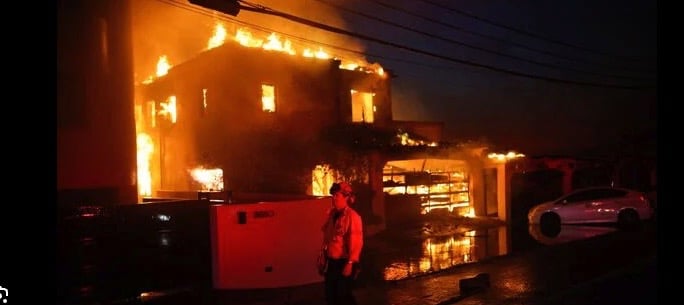The Unrelenting Battle Against LA Fires: A Community at Risk
An opinion about Los Angeles fires!
1/9/20253 min read


Los Angeles, a city celebrated for its vibrant culture and sunny skies, has long faced an ominous adversary: wildfires. In recent years, these blazes have intensified, fueled by climate change, urban expansion, and shifting weather patterns. The 2025 fire season has been no exception, with flames ravaging parts of Southern California, endangering lives, property, and the environment.
A Season of Devastation
California's fire season now stretches nearly year-round, with dry winters and record-breaking heatwaves creating the perfect storm for fires to ignite. In Los Angeles, several major fires have scorched thousands of acres, including residential areas near the Santa Monica Mountains and forested regions in Angeles National Forest. The notorious Santa Ana winds, which gust at speeds exceeding 60 mph, have fanned the flames, making containment efforts exceedingly difficult.
This year’s fires have not only burned untamed wilderness but have also encroached upon urban zones. Neighborhoods in Malibu, Calabasas, and the San Fernando Valley have been evacuated as the fires spread rapidly, leaving residents grappling with uncertainty and loss.
The Climate Connection
Experts are unanimous: climate change is exacerbating wildfires in California. Rising global temperatures have dried out vegetation, turning it into tinder. Prolonged drought conditions, combined with unpredictable rainfall patterns, have created a landscape that is primed to burn.
The effects of these fires are not limited to California. Smoke plumes from LA fires have traveled as far as Nevada and Arizona, degrading air quality and posing health risks to millions. As the intensity of these fires grows, so does their environmental toll, with massive carbon emissions contributing to a vicious cycle of climate warming.
Human Impact: Lives Upended
Behind every fire is a human story. Thousands of Angelenos have been displaced this season, forced to flee their homes with little more than the clothes on their backs. For many, the trauma of losing cherished possessions and the uncertainty of rebuilding is overwhelming.
Emergency shelters have sprung up across the city, offering temporary refuge to evacuees. Organizations like the Red Cross and local nonprofits have mobilized to provide food, water, and emotional support. Yet, the sheer scale of displacement has stretched resources thin, leaving many wondering if they will ever return to a sense of normalcy.
The economic cost of these fires is staggering. Insurance claims for damaged homes and businesses have surged, while infrastructure repairs and firefighting efforts drain state and local budgets. Small business owners, in particular, face uphill battles as they navigate closures and lost revenue.
Frontline Heroes: The Firefighters
Firefighters remain the backbone of California’s response to wildfires. In Los Angeles, thousands of men and women have battled blazes around the clock, often risking their lives to save others. Crews from neighboring states have joined the effort, illustrating the collaborative spirit that defines disaster response.
But the physical and emotional toll on these frontline workers is immense. Many firefighters endure grueling shifts in extreme conditions, facing heat, smoke inhalation, and the constant danger of shifting flames. Mental health support for these heroes has become a growing priority, as the cumulative stress of fighting increasingly destructive fires takes its toll.
What Can Be Done?
Addressing the wildfire crisis in Los Angeles requires a multi-pronged approach. Immediate efforts focus on fire prevention and mitigation. Controlled burns, which reduce fuel loads in high-risk areas, have proven effective but are not without challenges, particularly in densely populated zones.
Homeowners in fire-prone areas are encouraged to create defensible space by clearing flammable materials from around their properties. Building codes are evolving to mandate fire-resistant materials for new constructions, particularly in areas near wilderness zones.
On a larger scale, combating climate change is essential to reducing wildfire risk. Transitioning to renewable energy, investing in sustainable land management, and fostering global cooperation on carbon reduction are critical steps.
A Call to Action
As LA grapples with the ongoing fire crisis, community resilience and collective action have taken center stage. Volunteers have stepped in to support evacuees, neighbors have offered shelter to those in need, and local leaders are calling for increased funding for firefighting resources.
For the average Angeleno, staying informed and prepared is key. Emergency preparedness kits, evacuation plans, and participation in local safety drills can make all the difference when disaster strikes.
Looking Ahead
The fires of Los Angeles are not just a local problem; they are a stark reminder of the global climate emergency. As the city rebuilds and heals, it must also adapt to a new normal—one where fire seasons are longer, more destructive, and increasingly unpredictable.
Through innovation, collaboration, and a commitment to sustainability, Los Angeles can rise from the ashes stronger than before. The fight against wildfires is far from over, but with courage and determination, the city can protect its future while honoring the resilience of its people.
Awareness
Join us in raising awareness about injustices.
Action
Inspire
© 2024. All rights reserved.
